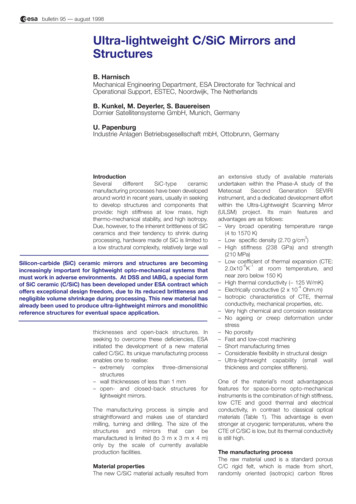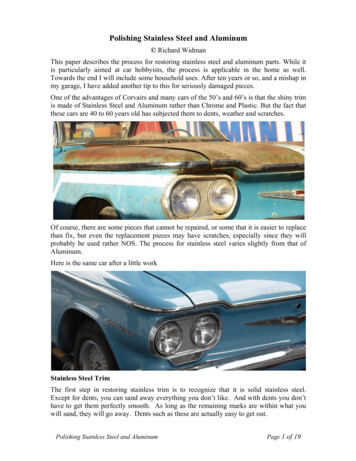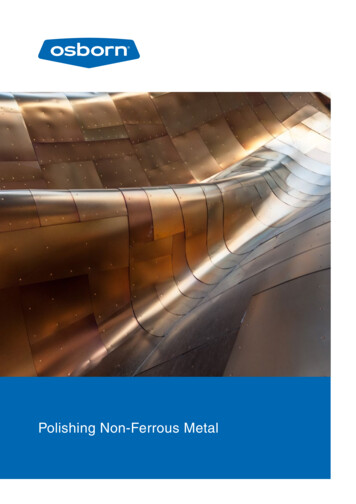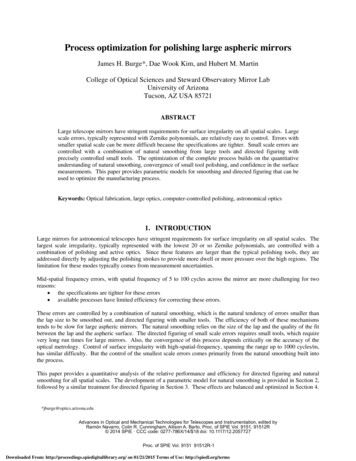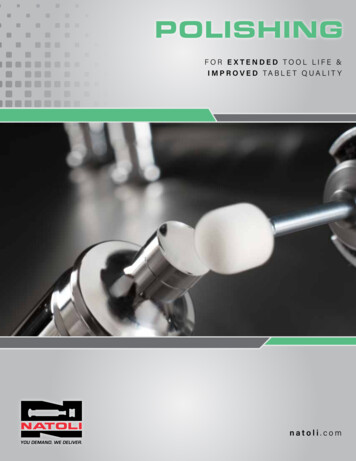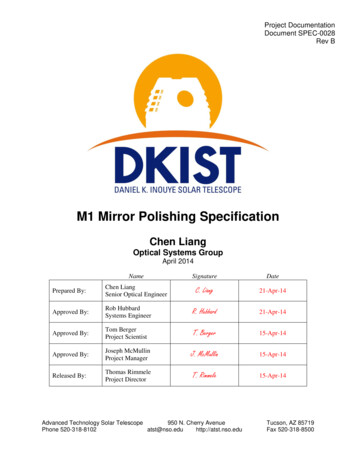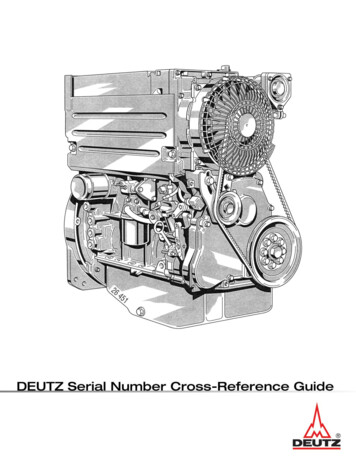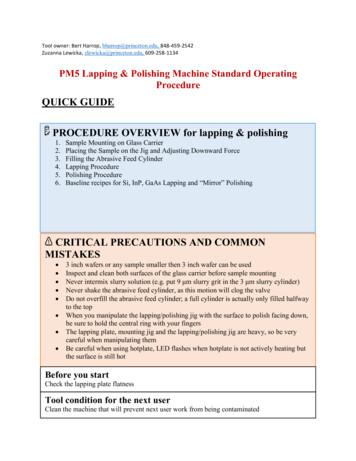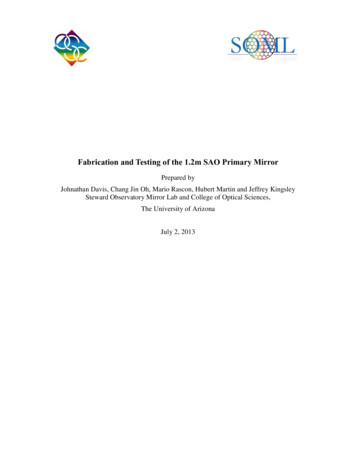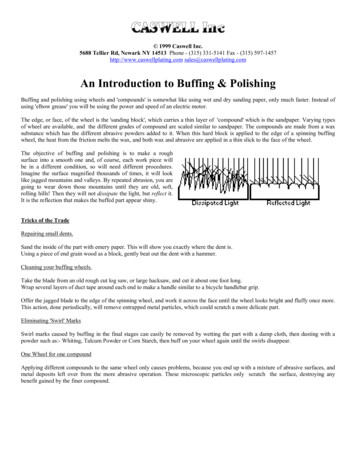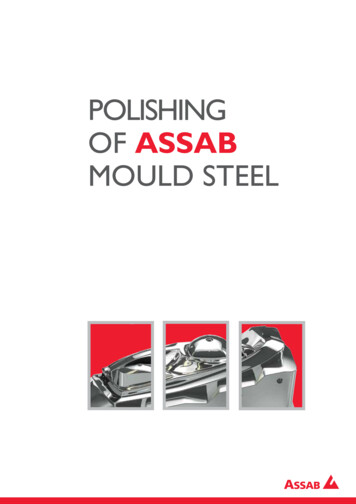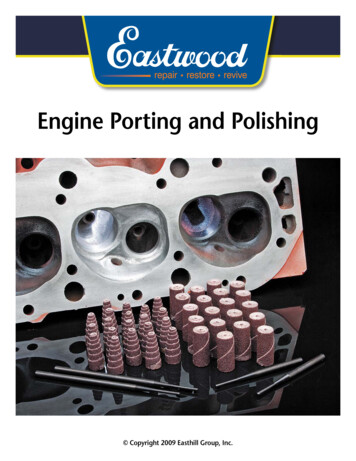
Transcription
Engine Porting and Polishing Copyright 2009 Easthill Group, Inc.
What It Is?“Porting” or “Port & Polish” refers to the reshaping andsmoothing of the intake and exhaust passageways in enginecylinder heads.Polishing heads, or removing flaws that restrict airflow, isnot difficult or costly. Beginners can polish their engine andrealize horsepower gains of up to 10%!BeforeAfterSafetyPolishing cylinder heads, when done properly, is safe and astraightforward task. However, you must take precautions toprotect yourself as well as your engine.Safety Goggles, Dust Mask, and Gloves must be worn at alltimes. Also avoid loose-fitting clothing, jewelry, or long-hair.Polishing involves removing metal with a high-speed diegrinder. It is essential that you, and anyone else helping orwatching, wear proper safety equipment to avoid injury fromany flying metal particles.Always wear safety gear during any porting operationEngine Porting and PolishingOrder 24/7 at eastwood.com or call 800-345-1178
BasicsBasic cylinder head polishing on OE cast iron heads canproduce respectable performance gains. Removing the flawsand imperfections that are found on OE heads and manifoldscan improve air flow, allowing more air to reach thecombustion chamber. As more air reaches the combustionchamber, you can add more fuel, increasing your engine’shorsepower!There are typically three main areas which restrict air flow:1. Rough Casting2. Unmatched Passageways3. Combustion ChamberAddressing these three problematic areas can make a big performance gains!Throughout this project, we want to remove as little material as possible. Air flow is more sensitive to shape rather than overallsize. Over-enlarged ports will not increase your horsepower. Haphazardly grinding-out your ports will weaken your heads,potentially causing leaks or cracks.Reshaping or redesigning ports is a much more advanced processes that requires a higher degree of scientific methodology andequipment to redesign the cylinder heads. However, if you are building a race motor and want to reshape ports and valve guidebosses, Eastwood sells many different carbide burrs that you can use.ProcedurePolishing is not an expensive job but it does take time and patience. Polishing is a great winter project, especially if you arealready working on your engine. Typical V8 cylinder heads take 12 hours to polish. Match the Intake Port Entry & Gaskets Polish the Intake & Exhaust Valve-Guides Areas Polish the Exhaust PortsEngine Porting and Polishing Polish the Intake & Exhaust Runners Polish the Combustion Chambers Match the Intake ManifoldOrder 24/7 at eastwood.com or call 800-345-1178
ToolsThe Eastwood Company offers all of the tools and materialsyou need to port your engine!Grinder’s GreaseAbrasive cartridge rolls and carbide bits often load up, reducingtheir cutting ability. Th is all-natural lubricant keeps your cuttingtools clean for fastest work. A must for cutting aluminum andother soft metals; 8 oz. tube. NOTE: The Grinder’s Grease issupplied in a semi-hard state. The friction of spinning buff, felt orburr melts a small amount onto the abrasive.13119Grinder’s GreaseEngine Porting KitMandrels for Abrasive RollsFor abrasive rolls with 1/4” arbor hole. Fits in standarddie grinders, both electric and pneumatic.13142131414” Mandrel6” MandrelSpecialty Carbide BurrsThese burrs really speed up the porting andpolishing process! Use the double cut, heattreated, carbide precision ground burrs witheither 3” or 6” long length shafts. 20,0000max RPM.Tool steel grade burrs are designed with rigidshafts for accurate porting in both iron andaluminum heads. Long reach allows deep bowlblending in both intake and exhaust ports.46058460676” Carbide Burr Set, 4 Piece3” Carbide Burr Set, 4 PieceTh is kit contains all the abrasive rolls and mandrels you’ll need to port a set ofV8 heads! Includes (20) tapered 80-grit rolls, (20) cylinder 80-grit rolls, (2) 4”mandrels, and (2) 6” mandrels. Simply attach the mandrel to your electric orpneumatic die-grinder and screw on an abrasive roll. (Grinder maximum RPM18,000). For Iron or Aluminum heads.46056Engine Porting KitAbrasive RollsExtra rolls for your project! Choose 80 grit(coarse), 120 grit (medium), 240 grit (fine)or 320 grit (extra fine). When workingon aluminum or other soft metals, useGrinder’s Grease for a smooth cut.Part ed105013088120TaperedCarbide burrs mounted on a 1-1/2”L - 1/4”dia 1050Shape and deburr quickly119168-Piece, Double-Cut Carbide BurrSet, 1/4” Drive Includes 2 cylindrical1/2” x 1” and 3/8”x3/4”; 2 cylindricalradius-end 3/8”x3/4” and 1/4”x5/8”;2 ball 1/4” and 3/8”; 2 tree radius end3/8”x3/4” and 1/2”x1”4-Piece, 6” Long-Reach Carbide BurrSet Includes: (4) 6” long 1/4” shaftburr with 3/8” ball; 3/8”x3/4” cylinder;3/8”x3/4” tree; 1/2”x1” treeEngine Porting and er 24/7 at eastwood.com or call 800-345-1178
Getting StartedIf this is your first porting job, we highly recommend that you find junk engine heads to practice on (preferably from the sameengine). Practice operating your die-grinder so that it removes metal in a smooth and controlled manner. Use a regulator tokeep the RPMs below the max speed. This will ensure a smooth and even finish while removing as little metal as possible.If you are working on aluminum heads, remember that aluminum will abrade much faster than cast iron.After you begin to feel comfortable using your die-grinder and abrasive rolls, completely clean your ‘good’ engine heads. Theywill need to be cleaned using an abrasive blaster, wire-wheel brushes, or taken to a shop to be “hot-tanked”.Once your heads are cleaned, carefully check for cracks and have them “pressure checked” for leaks if they are suspect to damage.Repair any damage before continuing.You will need the following:Intake manifold gaskets that will be used on the engineIntake manifold boltsExhaust manifolds that will be used on the engineOld valves that fit in your heads (these will protect your valve seats from damage)A metal scribe or finishing nailSafety glasses, gloves, and a dust-maskEngine Porting and PolishingOrder 24/7 at eastwood.com or call 800-345-1178
Step 1: Match the Intake PortEntry and GasketsAttach the Intake Manifold gasket to the head with themanifold bolts. Be certain that you have properly installedthis gasketUsing your scribe or finishing nail, outline the shape of thegasket onto the head.Remove the gasket and grind away any material that iswithin your scribe lines. Enlarging these ports will allow theair to flow easier as they enter the head from the intake manifold.Trace your gaskets, then remove the excess metal around the portsStep 2: Smooth the Intakeand Exhaust RunnersOnce you have enlarged the entry ports, begin workinginto the runners. Use your abrasive rolls to have a smoothtransition between the entry port and the runner.Look and feel down into each port for casting flash or otherrough spots. Grind away any casting flash or rough spots youencounter, removing as little metal as possible.Once all of the rough areas are grounded down, smooth andblend the entire runner so it is a smooth, continuous surface.Use the tapered rolls to get the curved walls of the runnerIntake runners are to be smooth, however, do not use anabrasive roll smoother than 80-grit. If the intake runners arepolished to a mirror-like finish, the air and fuel may not atomize correctly.Engine Porting and PolishingOrder 24/7 at eastwood.com or call 800-345-1178
Step 3: Polish the Intake andExhaust Valve-Guide AreaYou will find sharp edges on your short-side radius. Theseedges cause a lot of turbulence. It is very important to grindthem down as these edges cause a lot of air turbulence.When grinding short side radii, your grinder will be veryclose to your valve seats.BE VERY CAREFUL NOT TO TOUCH THE VALVESEAT WITH ANY MOVING PART OF YOURGRINDER!Old valves can help prevent damage to your valve seatsTouching the valve seat may result in an unusable valve seat, which will require a machine shop to repair.Step 4: Polish the CombustionChambersWhen polishing your combustion chambers, keep yourjunk valves in the heads to protect the valve seats.Combustion chambers often have sharp-edges that can causepre-ignition. Smooth these edges, removing as little metalas possible.As you work into the bowl, smooth the casting. Taperedabrasive rolls work well in this situation.Carefully remove any casting flash found in the combustion chambersRemember that any metal removed from the combustionchamber will proportionately reduce your compression ratio.DO NOT use carbide burrs when working in your combustion chambers.Engine Porting and PolishingOrder 24/7 at eastwood.com or call 800-345-1178
Step 5: Polish the Exhaust PortPolishing the exhaust port is similar to the intake port, however, we want a much more ‘mirror-like’ finish. Exhaust gases,containing carbon, build-up on exhaust port walls, restricting air flow. The ‘mirror-like’ finish will help prevent future carbonbuild-up.We offer abrasive rolls in 240 grit and 320 grit which can achieve a very smooth, polished finish.Almost all manifolds and headers have larger port sizes than the heads. This causes the exhaust to ‘step’ down as it exits theengine. This ‘step’ helps prevent exhaust gases from flowing back into the engine. In the rare case that your manifold or headerhas smaller ports than the head, you will want to port-match the manifold or headers (similar to step 6)Step 6: Match the Intake ManifoldLike the intake port, clean the gasket surface, attach the new gasket, and outline the gasket with a scribe. If there is a lot ofmetal within the scribe lines, use a carbide burr. Otherwise use your abrasive rolls.Clean UpOnce you are finishing polishing, clean the engine heads very well. Do not want any metal debris inside! Wash the headsthoroughly with hot soapy water and, while wearing safety glasses, blow them dry with compressed air. Be very careful of flyingmetal debris!The data and information contained herein are being furnished for informational purposes only. Upon the express condition thateach user shall make his or her own assessment of appropriate use and appropriate shipping, transfer, and storage of materials andprocedures for porting your engine. The Eastwood Company disclaim any liability for damage or injury which may result from the useof the above data, or it’s use for any specific purpose, even if that purpose is known to The Eastwood Company.Engine Porting and PolishingOrder 24/7 at eastwood.com or call 800-345-1178
Engine Porting and Polishing Order 24/7 at eastwood.com or call 800-345-1178 Step 5: Polish the Exhaust Port Polishing the exhaust port is similar to the intake port, however, we want a much more ‘mirror-like’ fi nish. Exhaust gases, containing carbo
